Cost, size and power must be addressed before terahertz spectroscopy can broaden its commercial acceptance – but steps are being taken.
Today, terahertz spectroscopy shows promise for some fascinating applications, from detecting illicit drugs and counterfeit pharmaceuticals to measuring the water content of plants and identifying hazardous trace gases. One reason terahertz has gained so much traction for these tasks comes down to the nature of its radiation. Terahertz is ideally placed between IR and microwave radiation, giving it a unique imaging power that crucially lies in the nondestructive region of the spectrum.
For detecting illicit drugs, for example, time-domain spectroscopy (TDS) systems are ideally suited. Pharmaceutical substances – and in general, most nonpolar organic solids – show fairly broad absorption peaks at terahertz frequencies. These chemical fingerprints are well detected with a time-domain terahertz system.
Other techniques such as Raman or IR spectroscopy also can identify most of the same substances, of course, but they require direct optical access to the sample.
“By contrast, one of the key strengths of working at terahertz frequencies is that the terahertz beam penetrates materials such as paper, cardboard or plastics. This opens the possibility to detect chemical agents or illicit drugs even through parcels or sealed mail envelopes,” said Dr. Anselm Deninger, product manager of terahertz technologies at Toptica Photonics AG. “The main advantages of time-domain techniques are their broad bandwidth and the relatively short data-acquisition time: A full spectrum is recorded within subseconds to several 10 s, depending on the number of averages.”
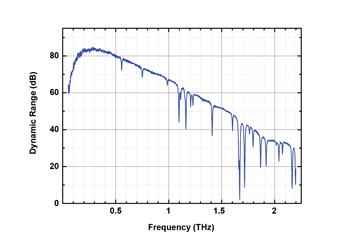
Performance of Toptica’s CW terahertz spectrometer: The dynamic range is 80 dB at 500 GHz and still >65 dB at 1.0 THz. The dips are absorption lines of water vapor. Courtesy of © Toptica Photonics AG.
Drug analysis is not just restricted to the illegal kind; polymorphic forms can also be identified. Various forms of the same chemical compound can exhibit different pharmaceutical properties, which are vital for drug manufacturers to remove from the production line. Different conformations or crystal packing of the same molecules can lead to different optical properties in the terahertz frequency regime, making them ideally suited for spectroscopic detection.
Water: Friend or foe?
At first encounter, water appears to be the enemy for terahertz radiation. Water is a very strong absorber at these frequencies; water vapor has distinct absorption lines more or less throughout the entire terahertz frequency range, and liquid water does not show any sharp peaks but causes broadband attenuation.
Medical research scientists find this a common problem when applying terahertz technology, because anything that takes place more than some hundred microns under the surface of the skin is impossible to reach due to strong water absorption of the terahertz signal.
But turn this around and measure instead the water content of a specimen, and you transform an enemy into a friend. By using the absorbing properties of water as contrast medium for imaging, you can potentially resolve fine differences in water content across a sample.
Terahertz for optimizing irrigation
Professor Martin Koch’s group at University of Marburg in Germany is taking this idea and running with it: The group has been measuring the water status of plants using terahertz TDS.
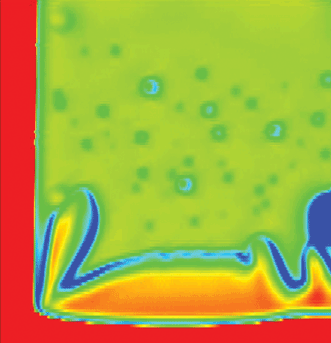
Terahertz transmission image of a fresh plant leaf 24 hours after cutting: The dried leaf shows only little remaining water content. (Leaf images are for Dr. Rafal Wilk’s dissertation, available at http://www.amazon.de/Switchable-THz-Reflectors-Rafal-Wilk/dp/3867273154, ISBN-13: 978-3867273152; Wilk, who completed this Ph.D. thesis under professor Martin Koch, is a leader of the terahertz business unit at Menlo Systems). Courtesy of Menlo Systems.
The water content in vegetative tissues is of high importance to plant scientists, as it is a good indication of general crop health. Until recently, one of the only ways to evaluate this parameter was to compare the weight of fresh, dry leaves. This does not allow for instantaneous or continuous monitoring of the water content in live tissues.
Terahertz TDS offers a noncontact, nondestructive alternative. “Here, the strong absorption of terahertz radiation by water becomes an advantage, as small changes in water content of a leaf can be detected very sensitively,” said Ralf Gente, a Ph.D. student in Koch’s group. “In future experiments, we will investigate the behavior of agricultural crops like corn, wheat or soy under drought stress and re-irrigation.”
Spectroscopy through smoke
Black smoke is opaque for visible light – there is simply too much scattering. But because terahertz light has a longer wavelength (roughly a factor of 1000), it experiences much less scattering, opening up the possibility of detecting toxic gases released by a fire – in a chemical plant, for example.
“A drawback of traditional techniques – chemical, optical or acoustic sensors – is their limited versatility: A chemical sensor, for instance, requires a dedicated receptor tailored to the gas species to be measured,” Deninger said. “However, the sensor usually saturates after being activated once, and then has to be replaced. If you want to detect several hazardous gases, you may end up with a whole battery of different sensors.”
On the other hand, a single terahertz spectrometer can identify a broad range of substances. It can even do so remotely, if the laser light is guided via optical fibers to the location of interest, transmitting the terahertz beam to exactly where it is needed.
“A CW terahertz source is the instrument of choice here – first, because it is much easier to transmit CW laser light through a long stretch of fiber and, second, because the spectral resolution is just so good,” Deninger said. “Our own CW terahertz systems achieve single-megahertz resolution, which helps you to identify trace amounts of gases unambiguously.”
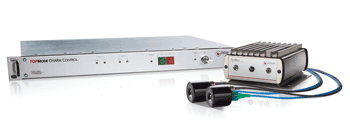
Next-generation CW terahertz spectroscopy system: The black cylinders in the foreground are fiber-coupled terahertz antennas, the box on the right-hand side is the laser head, and the “flatpack” box on the left comprises the driver electronics and data-acquisition unit. Courtesy of © Toptica Photonics AG.
Overcoming the challenges
Despite the far-reaching potential of terahertz spectroscopy, adoption by the mass market has not yet materialized. But what is stopping industry from turning its back on the established imaging and inspection tools such as Raman spectroscopy, IR and x-ray imaging and replacing them with the versatile, nondestructive terahertz alternative?
Some limits are simply determined by the laws of physics: Atmospheric absorption – especially due to water vapor – limits the transmission of terahertz radiation in air to a few meters at most.
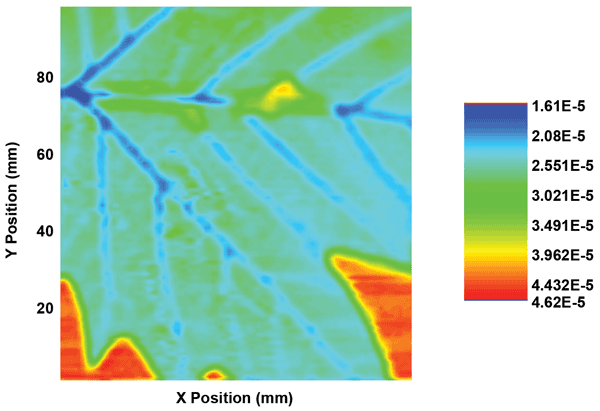
Terahertz transmission image of a fresh plant leaf recorded within 8 hours after cutting. Dark-blue color represents areas of high water content. Courtesy of Menlo Systems.
“There are different approaches to achieve broadband terahertz operation for spectroscopic applications. Optoelectronic systems have the advantage to be compact and easy to use. Robust and reliable femtosecond lasers allow pulsed terahertz operation where a broad spectral range is available for the measurement at once,” said Dr. Patrizia Krok, who handles international sales of terahertz systems at Menlo Systems GmbH. “Highest reproducibility of the laser parameters such as in our Figure 9 T-Light laser are the key to high-performance THz-TDS systems.”
Other challenges include the need for more compact systems at higher powers. To overcome this, engineering homework and sufficient funding are required.
“We admittedly have some sort of ‘hen and egg’ problem here,” Deninger said. “The price for a fully fledged CW terahertz system is on the US$50,000 - 100,000 level. This is still prohibitively high for broadband industrial use. On the other hand, it is generally agreed that prices will drop significantly and systems will become more mature, if only the sales volume grows large enough.”
Toptica uses optoelectronic terahertz generation techniques in which GaAs- or InGaAs-based antennas convert NIR laser light into terahertz radiation. This works, said Deninger, but the industry still expects smaller, lighter-weight control electronics.
“I think the industry expects more compact systems, more terahertz power, a higher dynamic range, a lower price and ideally a ‘push-button’ level of complexity,” he said. “So our next step is to shrink the size of our CW-terahertz system and make it more efficient at the same time.”
Another challenge is accessing the gap between around 4 THz (time-domain spectrometers) and around 12 THz (Fourier transform IR spectroscopy, or FTIR). Dr. Mira Naftaly and colleagues at the National Physical Laboratory in Teddington, England, are currently developing a terahertz optical parametric oscillator that will operate at 6 to 12 THz. This could enable widespread testing of a greater variety of materials and chemicals in industrial labs as well as in research; it would be comparable to Raman spectroscopy or FTIR.
While the list of hurdles is significant, most in the industry believe that the next five to 10 years will be very exciting for the field.
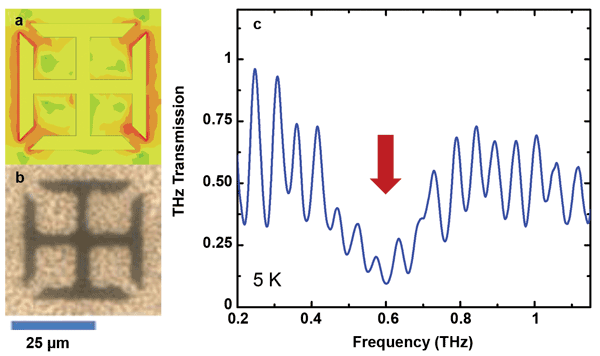
On-resonance field enhancement factor (a) and terahertz transmission spectra (c) of terahertz resonator pictured in (b). Micron-sized gaps in metamaterial structures can be used to spatially localize terahertz radiation to regions smaller than the wavelength and improve the contrast for biological sensing applications. Courtesy of Lake Shore Cryotronics.
“The evolution of Raman spectroscopy could be a helpful road map for thinking about the future of terahertz spectroscopy,” said Dr. David Daughton, applications scientist at Lake Shore Cryotronics Inc. in Westerville, Ohio. Lake Shore is a sensors, measurement and control specialist for a variety of research establishments. “The Raman technique is nearly a century old; a generation ago, Raman spectroscopy was isolated to well-equipped laser laboratories, and only in the past decade or so has the emergence of cost-effective diode lasers and filter technology enabled broad adoption of turnkey systems.”
What’s next for terahertz
With the availability of higher-power terahertz sources, materials that partially absorb terahertz radiation or thicker objects can be investigated. For example, Menlo Systems’ fiber-coupled terahertz antennas Tera15-FC already provide high power in their systems, and one of the UK’s terahertz companies, TeraView Ltd., claims to be developing a number of high-power sources that are both cost-effective and usable at ambient temperatures. These systems should be commercially available in the next two to three years.
Among the key developments for bio and medical applications, Daughton believes, are the metal and semiconductor structures that bring spectroscopy down to biological-length scales. To have sufficient sensitivity for bacterial detection, for example, semiconductor antennas can be used to couple free-space terahertz and direct the radiation to a 10-µm gap (which is filled with the specimen).
Also on the horizon is terahertz quasi-TDS, which uses a cheap multimode laser diode to generate terahertz radiation instead of a femtosecond laser. The technique promises to open up a new range of practical applications by massively reducing the cost, while at the same time allowing for much smaller systems that consume less power.